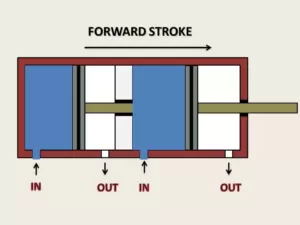Table of Contents
Tandem Cylinder
When two double acting cylinders are mounted in line with the pistons connected to a common piston rod, It is known as tandem cylinder.
Construction
It consists of two double acting cylinders joined with the common partition as shown in below figure.
It consists of two or more cylinders arranged one behind the other but designed as a single unit. This type of actuator cylinder is used in applications that require two or more independent systems. Fluid flow to and from the two chambers of the tandem cylinder comes from two independent hydraulic systems and is controlled by two sliding spool directional control valves.
The pistons are connected to a common piston rod. The four ports are provided (two inlet and two outlet ) which includes two ports of each double acting cylinder.
It has more linear dimension compared to simple double acting cylinder. Hence occupy more linear space.
Working
When oil enters in the cylinder 1, it produces force F1 and when enters in the cylinder 2 at the same time produces F2.
Hence at the piston rod, we can get double force (F1+F2) during movement of pistons.


Similarly for the return movement of the piston, we can get double force.
Pressure is applied to both pistons, resulting in increased force because of the larger area.

Symbol

Advantages and disadvantages of tandem cylinder
A tandem cylinder is a hydraulic system that consists of two or more hydraulic cylinders that are mechanically connected in series, with the output of one cylinder feeding directly into the input of the next.
Some advantages and disadvantages of tandem cylinders
Advantages:
Increased force: Tandem cylinders can provide greater force output than a single cylinder of the same size. This is because the force output of each cylinder is added together, resulting in a higher overall force.
Improved stability: Tandem cylinders can provide better stability than a single cylinder, as the load is distributed between multiple cylinders. This can be particularly useful in applications where a stable platform is needed, such as in heavy lifting equipment.
Better control: Tandem cylinders can provide more precise control over the movement of a load, as each cylinder can be individually controlled to achieve the desired motion.
Disadvantages:
Increased complexity: Tandem cylinders are more complex than single cylinders, as they require additional hardware to connect the cylinders together. This can increase the cost of the system and make maintenance more difficult.
Increased risk of leaks: Tandem cylinders have more connections and seals than a single cylinder, which can increase the risk of leaks and reduce the overall reliability of the system.
Higher power requirements: Tandem cylinders require more power to operate than a single cylinder, as the force output of each cylinder must be supported by the power input. This can increase the size and cost of the power source needed to operate the system.
Application
A tandem cylinder is used, where a large amount of force is required from a small- diameter cylinder. It also used if the space provided is not sufficient for a normal cylinder.
- Work holder devices and lathe equipment’s.
- Large press cylinder.
- Power operated flight control system in naval air craft
FAQ
- What is the tandem cylinder?
- When two double acting cylinders are mounted in line with the pistons connected to a common piston rod, It is known as tandem cylinder.
- Where is Tandem cylinder used?
- A tandem cylinder is used in applications where a large amount of force is required from a small- diameter cylinder.
- How does a tandem cylinder work?
- Tandem cylinders use multiple pistons connected through a common rod to generate relatively high force from a low supply pressure and small bore. … For example, a tandem cylinder uses two or more pistons connected to a single piston rod to multiply force produced by a cylinder without increasing bore size.
